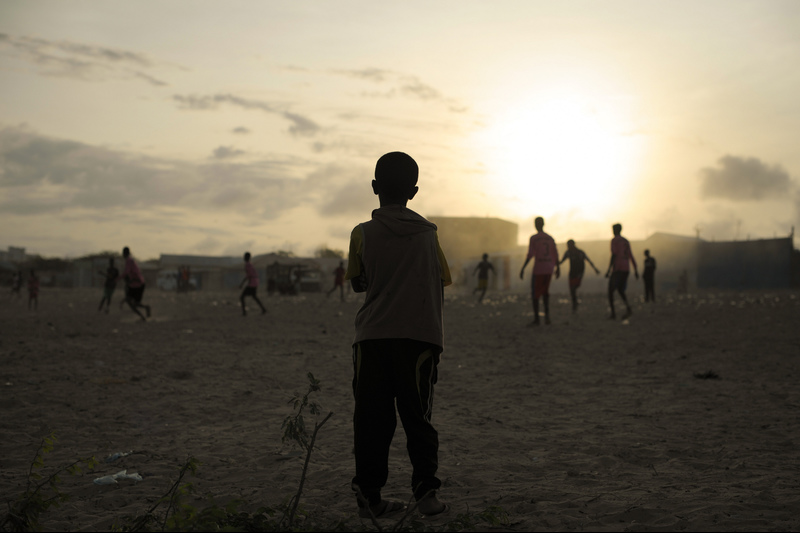Autism in an African context
10 October 2017 | Story Lisa Boonzaier. Photo AU UN IST Photo / Tobin Jones.
Autism research up to now has been rooted in the world's high-income countries. Tools for autism screening and diagnosis were developed in wealthy countries, and what we know about autism prevalence is derived from these regions, too. As we recognise World Mental Health Day on 10 October, we take a look at the work being done by UCT's Centre for Autism Research in Africa.
Thinking globally
Autism is a neurodevelopmental disorder that affects people worldwide, regardless of their ethnic, racial and cultural background. The World Health Organization recognises the spectrum of autism disorders as a growing, global public health concern; it may represent one of the greatest health burdens among children and adolescents.
In high-income countries, autism is one of the most prevalent neurodevelopmental disorders and almost everything we know about the disorder comes from these areas (mainly the US and Europe). In the US, one in every 68 children lives with autism. “But we don't know much about the disorder in the rest of the world – that is, in low- and middle-income countries, where 90% of children with autism live,” says Professor Petrus de Vries, Sue Struengmann Professor of Child and Adolescent Psychiatry.
“There haven't been any studies of the prevalence of autism anywhere in Africa, for example,” he adds. This is despite the prediction that 40% of the world's children will live on the continent by 2050 and that 1–2% of them are likely to have autism or a related autism spectrum disorder.
In sub-Saharan Africa, almost all healthcare work for children to date has focused on communicable diseases, such as HIV, tuberculosis and malaria, and on reducing infant mortality. This means that there has been almost no focus on disorders like autism, and the success of the actions for communicable diseases means more children are surviving in the region – and therefore the rates of neurodevelopmental disorders like autism are likely to be increasing.
De Vries along with his interdisciplinary research team at the Centre for Autism Research in Africa, which has collaborations in many African countries, is heeding the growing need to address autism in low- and middle-income parts of the world.
“When I first returned to South Africa after almost two decades abroad, I couldn’t quite understand why no-one had done a study to determine how many people with autism are in South Africa or Africa, ” says De Vries. “But I soon realised that there were many possible explanations.
“Developmental disability research has so far not been a priority in Africa, very few funds are available for this kind of research on the continent and very few people have the skills to do high-quality research on autism in Africa. But, even more fundamentally, I realised that we do not have standardised screening and dianostic tools that have been shown to work well in Africa.”
Culturally appropriate assessment
The gold-standard instruments for diagnosing autism were developed in high-income countries, but it is not known how well such tools will work the African context. “And it is difficult to imagine how to translate these tools, and train clinicians and researchers across Africa where at least 2 000 languages are spoken,” says De Vries.
This is among the challenges he is investigating: Can the existing autism evaluation tools be used appropriately and successfully among African cultures?
De Vries and his colleagues translated one of the gold-standard instruments, known as the Autism Diagnostic Observation Schedule-2, into Afrikaans, and one of his former postgraduate researchers, Lesia Smith, examined its feasibility among a group of coloured participants in the Western Cape. This test is increasingly being used in South Africa, although mainly among English speakers. Little is known about its usefulness in other South African languages.
“When assessing an individual, we need to be mindful of their cultural background and interpret their behaviour in accordance with that culture,” says Smith. “In the same way, we need our screening and diagnostic tools to be sensitive to the cultures of those being assessed.
“To diagnose autism spectrum disorder in a particular culture, we need to be familiar with what behaviours are acceptable and unacceptable in that culture.”
Smith and her colleagues looked at whether the language, activities and materials in the test were understandable and appropriate for the 47 participants, who were limited to coloured, Afrikaans-speaking people from low- to middle-socio-economic backgrounds. They also investigated whether social interactions between children and adults were deemed appropriate to them.
Overall, they found that the test could be appropriate for this cultural group – with caveats. The study identified 20 Afrikaans words, for example, that were difficult to understand for some of the participants. These were mainly related to emotions or feelings, such as lonely (eensaam), cheerful (vrolik) and upset (omgekrap). The researchers recommend that administrators be aware of these difficulties and give participants more explanation whenever it is necessary. Although most of the language, activities and materials were unproblematic, examiners who administer the test need to be culturally sensitive.
In a similar study, done in collaboration with Dr Amina Abubakar at the Wellcome Trust’s Kenya Medical Research Institute, researchers translated the same test into Kiswahili and assessed its application in Tanzania. They saw similar results: Most of the concepts in the test were familiar to the cultural group they looked at, but they still had concerns about specific tasks and materials. And the costs of training and translation remain.
Opening access
Early screening and diagnosis for autism is crucial for identifying children who require treatment. Efforts such as those by De Vries and colleagues to validate existing screening and diagnostic tools in an African context will provide external benchmarks for future research in Africa. However, given the challenges of translating, validating and funding the current tools for autism diagnosis, De Vries believes that Africa – and the rest of the world – urgently needs open-access, free, globally relevant alternatives. Many of the existing tools even require a fee to be paid to their publishers each time their test is administered.
Free, open-access tests would overcome many of the barriers posed by current autism screening tools, and by being globally and culturally relevant, they would make the field more inclusive.
Forget the intervention
“The next fundamental need is to make sure that children and families have access to appropriate, evidence-based interventions,” says De Vries. “It is pointless, and probably unethical, to identify people with autism spectrum disorder if we don't have interventions for them. And this is an enormous challenge in Africa.”
In high-income countries, there are a range of interventions for people living with autism, including parent training, and group-based and individual therapies. “We will never have a therapist for every child with autism spectrum disorder in Africa,” he says. “So we are very interested in parent- and carer-led interventions where we train people to coach parents, carers and families to work with their children and other family members. There is good evidence that it is possible, as long as we do it carefully and thoroughly.”< /p>
De Vries and his team at the Centre for Autism Research in Africa are looking at these areas – screening and diagnostic tools, and options for intervention in Africa – as well as the role technology that could play in solutions. They hope to understand and improve health and education systems for children with autism in Africa.
World Mental Health Day | 10 October
World Mental Health Day is observed on 10 October every year. It is a day for education, raising awareness of mental health issues, advocacy against social stigma and mobilising efforts in support of mental health. This year the theme is 'Mental health in the workplace'.
 This work is licensed under a Creative Commons Attribution-NoDerivatives 4.0 International License.
This work is licensed under a Creative Commons Attribution-NoDerivatives 4.0 International License.
Please view the republishing articles page for more information.
Research & innovation





































